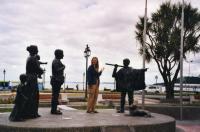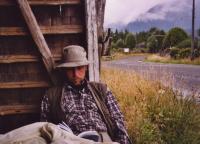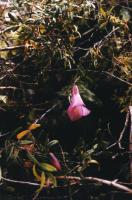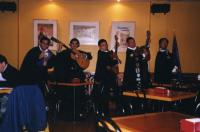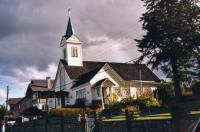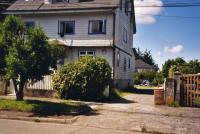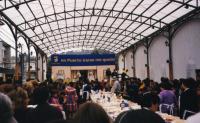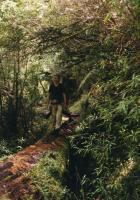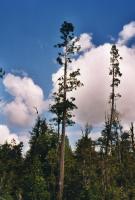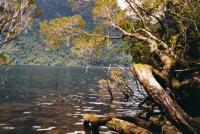
Volcan Osorno, from Puerto Varas
Click on a photograph to enlarge it. More photographs here
Travelogue 4, in which we move further north, encountering rain and cold, but finally enjoying some magnificent treks in the Chilean Lake District.
beloved friends
doesn't time fly when you are having fun and a travellogue seems to be
long overdue. in fact there are already two new accounts of our
experiences in this part of the world and i will start to hack in the
first one to provide you with more bedtime reading material
so here we go:
last time we were about to jump on the bus to
coyhaique, the capital of
chiles remote XI region. Coyhaique (pronounced coy-AI-key, meaning
landscapes of lakes) sits in a sheltered valley behind moutain ranges to
the west. it is a small city with a population of 40,000 people which
sums up half of the whole regions population. Coyhaique marks the line of
climatic transition between the moistern (well experienced by us:) western
patagonia and the drier eastern steppes. the mountains surrounding the
city are almost 2000m high, often snow capped to the west and become dry
aand barren a short distance to the east.
there are two national parques in the area, cerro castillo and rio simpson, promising superb trekking through all kind of magical nature.
to get there from puerto natales the bus takes up to 24 hours and rides most of the time through argentinia. so freshly washed, creamed, fed and wearing clean clothes we embark on this journey. the bus is full with families - we are actually the only foreigners. it is a comfortable pullmann, good seats and reasonably spaced. being surrounded by kids here in chile for me is quite a different experience as they are never a nuisance (please note: i am talking with no maternal experience here). they somehow blend in the whole noise scheme and you rarely hear a child crying or shouting, very selfcontained - my guess is that they feel very much loved and obviously getting kissed a whole lot must work as well (as i already mentioned the kissing obsession in chile).
we take off only to have a lunch break at the first greasy spoon (for non english native: a plastic cheap snack bar :) ) that we pass. after a couple of hours drive we reach the border to argentinia and everybody has to get out, queue up to get a leaving stamp in the passport - the whole procedure takes about an hour, then everybody gets back into the bus and we drive about 50 meteres - and get out again to be registered by the argentinian border patrols - there goes another hour. after collecting everybody again, we drive into argentinia.
i am wondering if travelling by that speed we will actually ever make it to coyhaique. finally we are moving into the first town rio galegos and to my disbelief stop at the first supermarket. the drivers go off to get their and probably the whole villages groceries. since their money de-evaluation argentinia has become much cheaper than chile - that is also the reason why there are less tourists in chile this year because the argentinians stay at home and the chileanos go to argentinia. it takes ages for our drivers to emerge from the shop again, loaded with bags of food.
as soon as we get going again the caretaker goes around offering us sweet
cakes filled with delicious pudding and coffee which consoles me
instantly
the caretakers on the bus are really doing an good job. when fallen
asleep they cover you with a blanket, they put the chair back in a more
comfortable position and are always around to help. so the journey is
very pleasant. we watch spiderman in spanish and a couple of other movies
before falling asleep. next morning it is border crossing ceremony again.
after the whole procedure and filling out forms and getting a new entry
stamp in our passports we are approaching coyhaique, riding over
mountains in sunshine and blue sky - yupiiee!
we quickly find a hospedaje and after i explained the concept of having a toasted bun without anything meaty on it in spanish to a waitress, we even have a good breakfast. we check out town and i am really excited about the prospect of hiking in these mountains. when we wake up from our afternoon nap the sky is nearly black and full of heavy clouds. soon enough i hear the sound of falling rain and this sound just stays with us for the next two days. we move from snackbar to snackbar or curl up in the room - there is no end to the rain. i check out weather reports on the net and it looks very bleak. the snowline moves right down and it doesn't make sense to set off on a moutain hike in these conditions. it is very very cold already down here - i don't want to imagine how it is up in the mountains and the views are probably under 10 meters. we stick it out for two days and then we give up - don't fight the river!
we jump on a plane to puerto montt, the gateway to the national parques of the southern chilean lake district and the island of chiloe. puerto montt is a booming port city with around 100,000 inhabitants (we are talking town here)and transport hub for bus travels in all directions from its huge terminal and ships going down the west patagonian canals.
after an uneventful flight (it was a kind of a bigger plane) we arrive in town and take a stroll. our accomodation has a ensuite bath, which seems rather luxurious after weeks of sharing bathrooms or being outdoors. actually one spends a little amount of time in a bathroom compared to the space it takes up... soon enough the sky darkens and it starts to rain and we are in for the same scenario, just this time we have considerably more choice of snackbars, shops and markets. we decide to be tourist for a couple of days and stop looking anxiously out of the window or up towards the sky every five minutes. we visit a not very interesting museum with the main attraction being the plate, the glass, the cutlery and the menu pope the pollack had used on his lanchile flight to puerto montt. not to forget a piece of concrete from the place where he kissed the earth - talking about cult...
after two days we know puerto montt inside out. the town and the area
around is heavily germanised with having a "deutscher verein" in every
town, good quality kuchen (it is even
part of the language)and restaurant
named bauer or likewise. also i spot the first non-white bread since
weeks - pan integral - and later
in the supermarket i buy a bread
labelled "schwaebisches vollkornbrot".
no change on the weather front and getting tired of the city buzz we move
on to puerto varras, a picturesque
little town on the shore of lago
llanquihue, the largest lake in the area. it is only a twenty minute
bus ride away but refreshingly rural and laid back. from the seafront you
get a full view of volcano osorno (2652m),
the most beautiful volcano i
have ever seen. we are in geothermal region here - with clear views one
can see countless volcanoes, mostly not active any more. last big
outbreak was 1960 volcano puyehue,
which we plan to trek for a week.
we find a great backpacker run by a chileno who lived in germany (to learn useful things for example: how to get up early o-tone mauricio) for a couple of years and his swedish girlfriend. it is a beautiful setup with a great kitchen and all utensils needed. off we go to the supermarket to change our diet to joghurts, fresh fruits and vegetables - grand. my digestive system goes in a bit of a shock by the intake of roughage but soon complies. on our arrival day the town celebrates a dia del kuchen - yes a kuchen festival. everybody in town donated a cake which is lined up on a seemingly endless long table - i have never seen so much cake in one place. the public can buy kuchen voucher which they do frantically and waving same to the servants at the kuchen table. all that is accompanied by a kind of very german sounding folk music and girls in trachten - it is great fun to float through this fiesta.
a leaflet says the church here looks like marienkirche in schwarzwald - if anybody knows where that is, please let me know. as the weather continues to be foul we decide to take day trips. the first one takes us to petrohue at the foot of volcano osorno and we walk up to a first stage of the path to the top. we even get a peak at its snowcapped top for a while. to climb to the top one needs ice axes and crampons - not our scene, specially not with such unstable views. next day we explore the city of osorno and notice a slight change of the weather - more blue sky and a bit of sunshine. on the way back to puerto varras we stop over in frutillar, the most german developed village. it is exceptionally clean and we find the kuchenhaus to buy streuselkuchen and vollkornbrot. every year the village stages a very well-known festival of classical music, for which they are in the process of building a big oysterlike stage on the water.
exhilarated by the prospect of better weather we return and plan to go off next morning. after 6 days we are longing for the great outdoors. we choose a two day trek in the national parque alerce andino, a reserve for the giant alerce, an extremly slow-growing native conifer. the areas relatively inaccessability has prevented major exploitations of its stands of giant alerces. the tree are now saved from woodcutters and the most ancient one may exceed 4m in diameter and reach several thousands years of age. the parques moist and mild climate is also home of luxuriant rainforest which grows at almost visible speed.
when we set off in the morning it looks promising but during the bus-ride the skies darken more and more. on our arrival the really nice and friendly parque guardians tell us that the second part of the path is flooded and impassable - grand! they had a lot of rain this summer. i meet a scottish couple which just returned from the trek and they tell me it is pretty boggy and to hear that from the scots, who grow up in boggy terrain, is not very encouraging. they camped at the first stage - while we talk it starts pouring down. jalal and me are so happy to be out again that we decide to camp on the conaf campsite in the forest which is a delightful place - even in the rain. we pitch tent, have a cup of tea and set out to explore more of the area. in the rainforest it actually doesn?t really matter whether it rains or not - it is such a magical moist world of green wonders and we are completly shielded under huge ferns, trees and other plants. we have a great time and when we return to the site it even stops raining and we can cook and eat outside. it is extremly mild and after all the camping down south it feels quite subtropical and rather hot.
next morning the sky is blue and we do a day walk to the first stage laguna sargazo. it is very muddy and a lot of wet root climbing but without the pack really easy going. we sit silently with ancient alerce trees, watch lizards basking in the sun and arrive at the shore of the lake to have a nice picnic and a nap. on our way back we have our first encounter with one of the nasties of chile, tabanas = blood sucking horse flies, the size of my thumb, with the sound of a B52 fighter plane. they look like mutated monsters escaped from the laboratory - their main season (when there are swarms of them - for me one is enough) is in january. that was also one of the reasons to start in the south because it is too cold for them down there. they prefer to live and suck in warmer climate.
we spent a second night a the site and break camp next morning to return to puerto varras. now the weather really changes and we only want to camp a night in the garden of our place, as we plan to head off immediately next morning to do the 5 day long puyehue traverse. so quickly to the supermarket, stocking up on food (our newly discovered source of proteins is soya chunks, heavenly light to carry and soo tasty in about every dish we cook) and a shower. we are all juiced up and ready for the trek which will lead us up to a broad volcanic plateau with lot of geothermal activity, such as hot springs . it covers a distance of 75km and a climb to the edge of the crater of the volcano.
so off we go and you will soon read all about it in a new edition of the travelloques. i hope you enjoyed the read.
we sent lots of love and hugs your way
ajara and jalal
editorial note: for all the native english speakers - in the last edition i referred to herings in connection with the tent. the right expression for this part of the gear in english would be tent pegs - in german "herringe" which jalal found so hilarious, that we adopted the word in our lingo. so i wasn't talking about little smelly fishes eaten by smelly penguins... just thought i clear that up
Contact: treks@gnomedia.com
